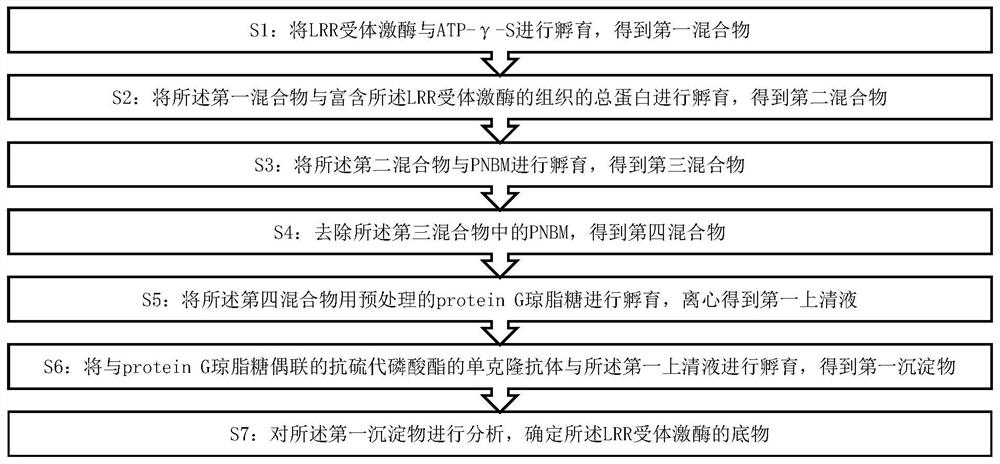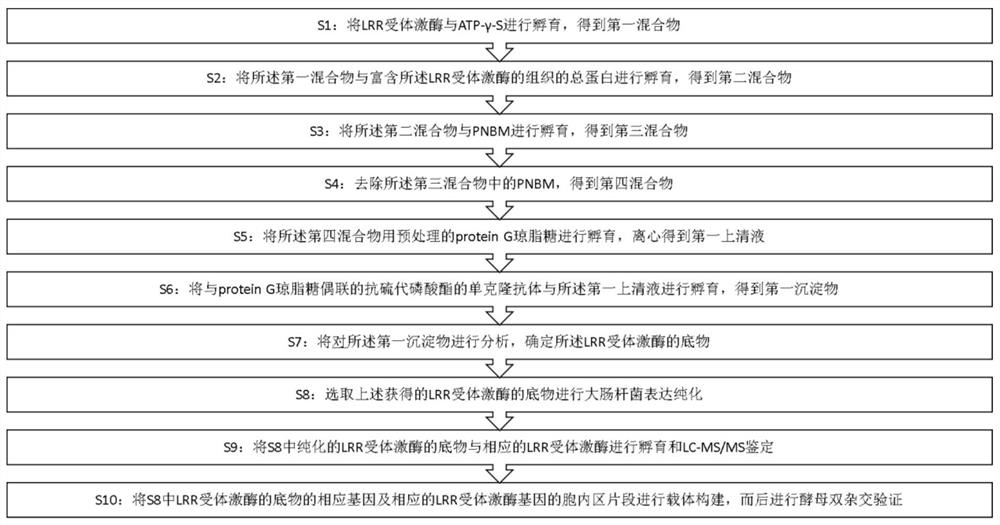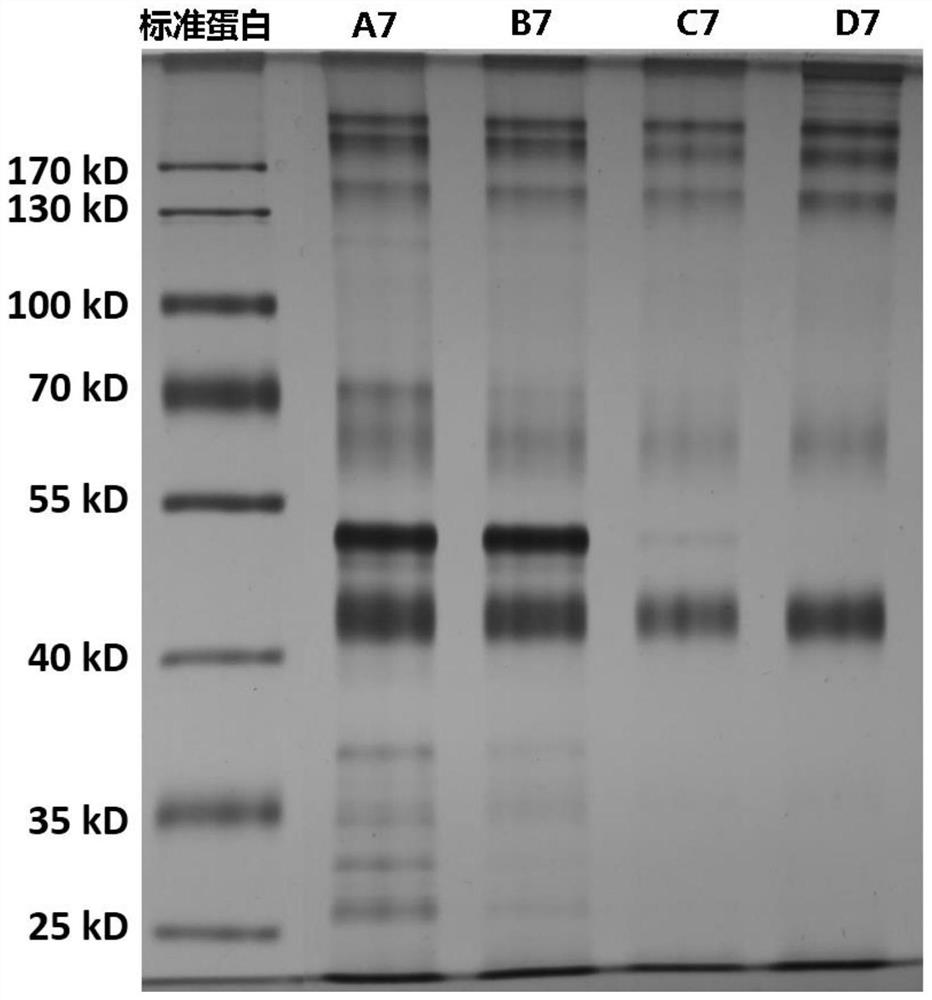A substrate-seeking approach for lrr receptor kinases
A technology for receptor kinases and substrates, applied in the field of substrate search for LRR receptor kinases, can solve problems such as low yield, difficulty in finding direct downstream substrates, limited use of false positives, etc.
- Summary
- Abstract
- Description
- Claims
- Application Information
AI Technical Summary
Problems solved by technology
Method used
Image
Examples
Embodiment 1
[0154] Pretreatment of protein G agarose:
[0155] (1) Take 640 μl of protein G agarose (Protein G agarose beads produced by Beyond Company, 2ml specification, product number is P2009), and divide into two equal parts. Centrifuge at 13000rpm, 4°C for 15s, discard the supernatant;
[0156] (2) Resuspend protein G agarose with 1.3ml of the first phosphate buffer (0.1M KH2PO4, 0.1M K2HPO4, pH 7.5), centrifuge at 13000rpm, 4°C for 15s, discard the supernatant, and repeat three times.
[0157] (3) Add 540 μl of the first phosphate buffer to the protein G agarose with a volume of about 100 μl in step (2), the total volume is about 640 μl;
[0158] (4) After mixing the suspension in step (3), pipette 200 μl of the suspension from one tube and add it to another tube. The smaller tube (about 440 μl) is used to remove non-specificity before immunoprecipitation Binding protein; one larger tube (approximately 840 μl) for later immunoprecipitation. Both tubes were placed at 4°C for late...
Embodiment 2
[0160] Anti-phosphorothioate monoclonal antibody conjugated to protein G agarose:
[0161] (1) Prepare four 1.5ml centrifuge tubes, add 788μl deionized water and 132μl second phosphate buffer (1MKH 2 PO 4 , 1M K 2 HPO 4 , pH 7.5);
[0162] (2) Take out 200 μl from the large tube of protein G agarose processed in Example 1 and add them to four new 1.5ml EP tubes, and name them as A, B, C, and D respectively;
[0163] (3) Centrifuge the four EP tubes in step (2) at 13000rpm, 4°C for 15s, and discard the supernatant. Then add the solution in step (1) one-to-one to A, B, C, and D tubes respectively, and mix well;
[0164] (4) Add 4 μl (1 μg / μl) of anti-phosphorothioate monoclonal antibody (manufactured by ABcam, 50 μl size, catalog number ab92570) to each tube of step (3). After mixing, shake gently at 4°C for 5 hours;
[0165] (5) Centrifuge each tube in step (4) at 13,000 rpm at 4°C for 15 seconds, and discard the supernatant. After resuspending with 1.3ml of boric acid ...
Embodiment 3
[0171] Substrate search for LRR receptor kinase-PXY:
[0172] S1: Incubate PXY with ATP-γ-S to prepare the first mixture:
[0173] (S11) Take four 1.5ml EP tubes and name them as A1, B1, C1, D1 respectively, and the C1 and D1 tubes are used as the control group.
[0174] (S12) Add 20 μl 10 μM PXY, 8 μl 10 mM CLE41 (sequence HEV Hy PSG Hy PNPISN; Hy P, means 4-hydroxyproline, synthesized by Shanghai Sangong Company), 1μl 1mM ATP-γ-S and 21μl kinase buffer (25mM Tris-HCl, pH 7.5, 0.5mM DTT, 10mM MgCl2) (containing 0.225mM dodecyl -β-D-maltoside);
[0175] (S13) Add 20 μl 10 μM PXY, 1 μl 1 mM ATP-γ-S (manufactured by ABcam Company, 1 mg specification, product number is ab138911) and 29 μl kinase buffer (containing 0.225 mM dodecyl-β-D-maltose) to tube B1 glycosides);
[0176] (S14) Add 1 μl of 1 mM ATP-γ-S and 49 μl of kinase buffer (containing 0.225 mM dodecyl-β-D-maltoside) to tube C1;
[0177] (S15) Add 50 μl of kinase buffer (containing 0.225 mM dodecyl-β-D-maltoside) ...
PUM
 Login to View More
Login to View More Abstract
Description
Claims
Application Information
 Login to View More
Login to View More - R&D
- Intellectual Property
- Life Sciences
- Materials
- Tech Scout
- Unparalleled Data Quality
- Higher Quality Content
- 60% Fewer Hallucinations
Browse by: Latest US Patents, China's latest patents, Technical Efficacy Thesaurus, Application Domain, Technology Topic, Popular Technical Reports.
© 2025 PatSnap. All rights reserved.Legal|Privacy policy|Modern Slavery Act Transparency Statement|Sitemap|About US| Contact US: help@patsnap.com



